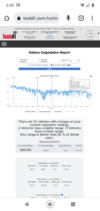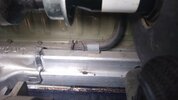Research may indicate that low SoC is better for battery in terms of capacity loss but Tesla's own battery loss is not as severe as other batteries thanks to their Battery Management System/Software.
No, it's actually the chemistry Tesla uses that has the biggest effect. BMS/software has little to nothing to do with it and even active thermal management does not have a large effect, except in hot climates or when doing lots of DC charging.
I had one of the first Nissan LEAFs, notorious for the rate of capacity loss and geeked out on how to minimize the rate of capacity loss while monitoring SOC and battery pack temperatures.
Despite the lack of active thermal management, pack temps rarely climbed significantly over ambient except when DC charging - and because of the limited range, you typically didn't do this all that often. Monitoring cell voltages, Nissan was far more conservative than Tesla - Nissan limited the pack to 4.1 V / cell at 100% where Tesla is only 90% there. Cell to cell balance was maintained just as well as Tesla.
And thanks to thermal management, Tesla actually tends to run the pack hotter than the LEAFs pack in my climate since it will actively direct heat from the onboard charger when L2 charging and heat from the motors to the battery when driving.
Despite this, my LEAF lost 30% capacity after about 5 years despite charging to 80% daily and rarely DC charging. My Model 3 is around 4.5 years old now and no where near that, but probably down 10% or so. For sure, in this comparison, the Tesla sees much fewer cycles of the battery since it's bigger - that helps, too, but with most capacity loss data for Tesla's, the rate of capacity loss tracks better with the age of the pack, than miles.
As I said earlier and will repeat: it does not matter at what % you charge at as long as it remains under 90%. Folks are taking this too literally and your posts, while trying to ber helpful, is not being helpful in determining the charge and helping ease owners mind that it really doesn't matter.
You are wrong. Maybe in your climate up there in freezing Edmonton it doesn't matter much, but for most people, it does and there's plenty of actual studies to prove it.
Too many of you are overthinking this. Just charge every night if possible and be happy.
Sure - just charge to the lowest SOC that you need on a daily basis.




